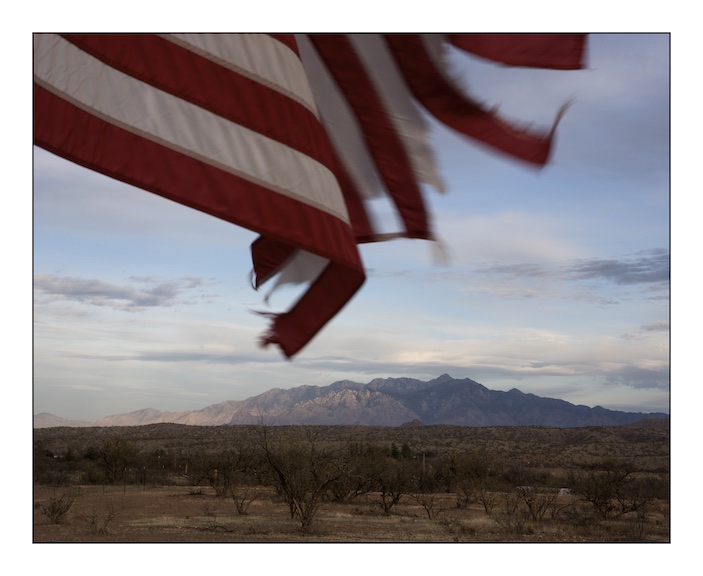
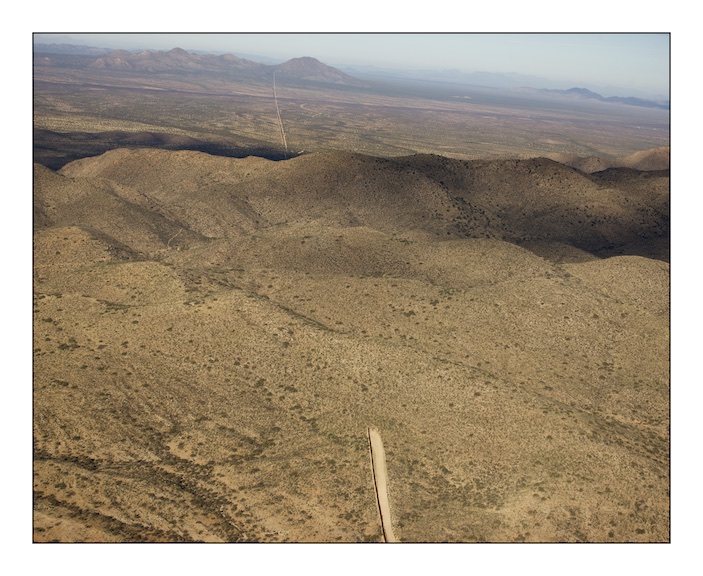
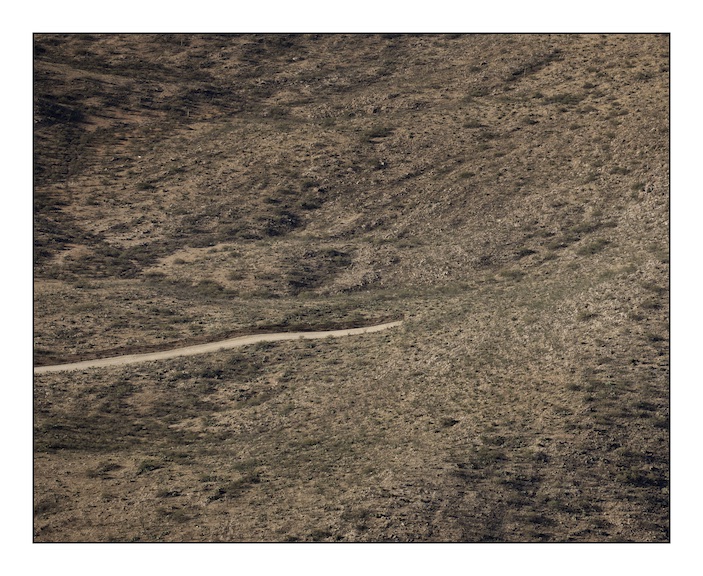
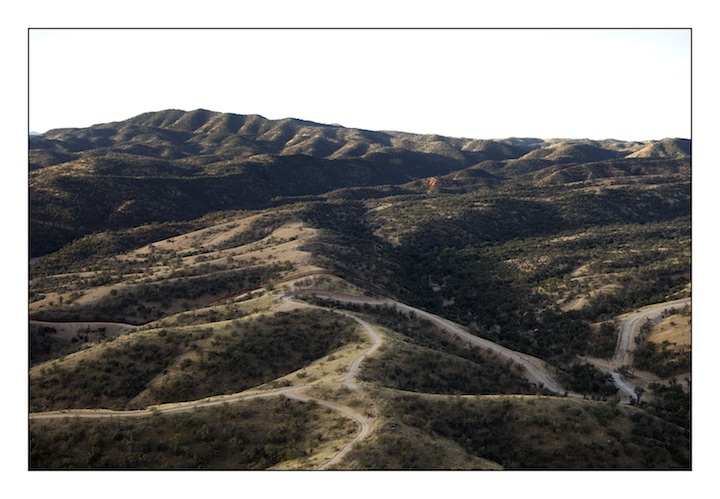
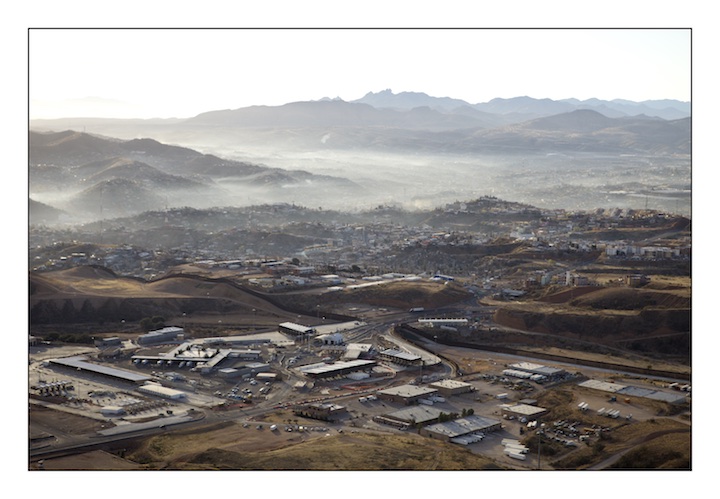
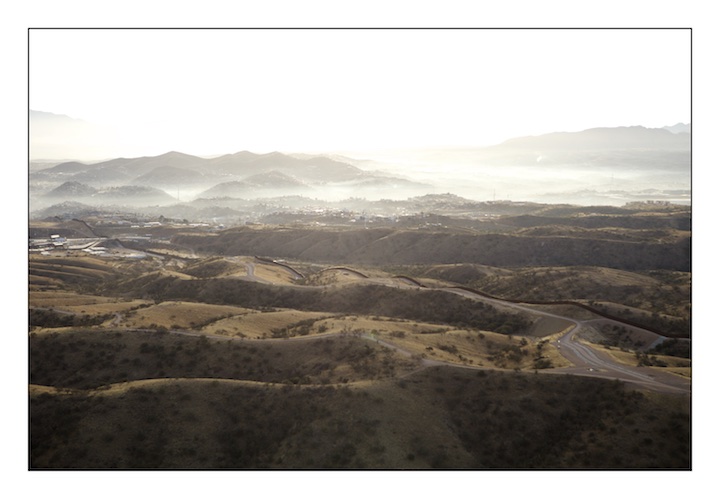
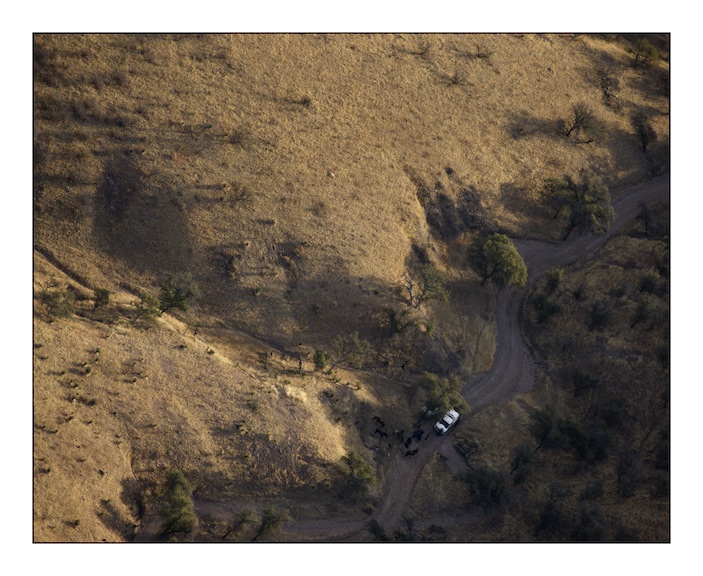
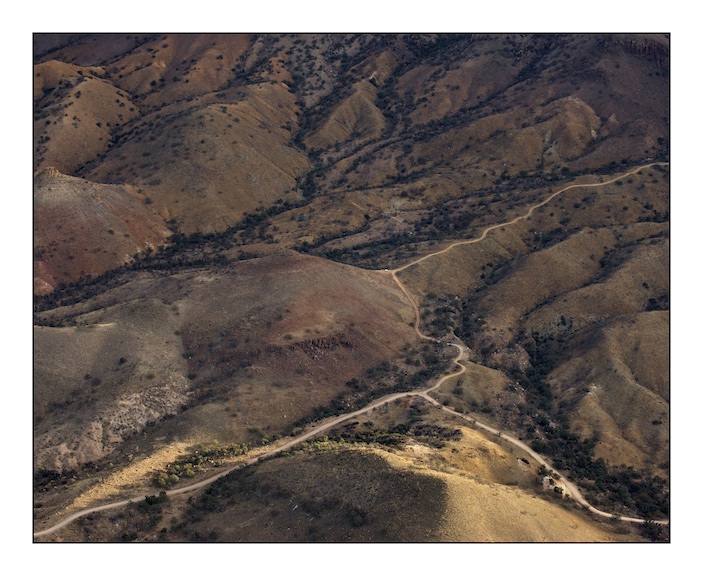
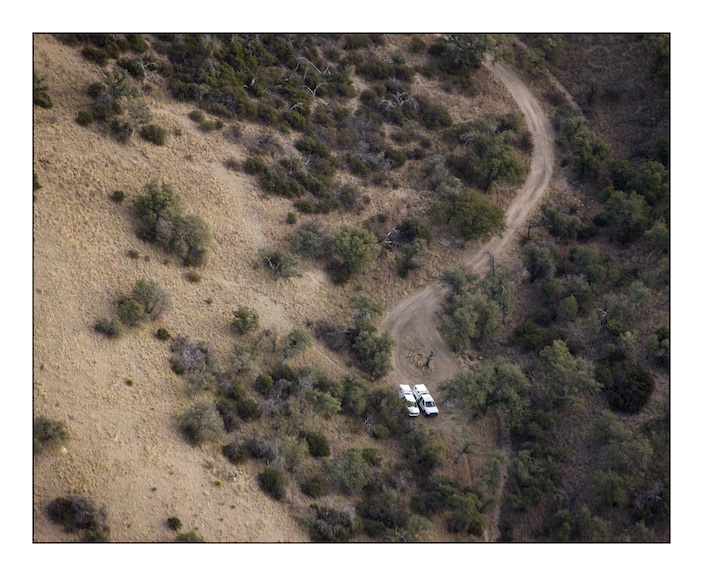

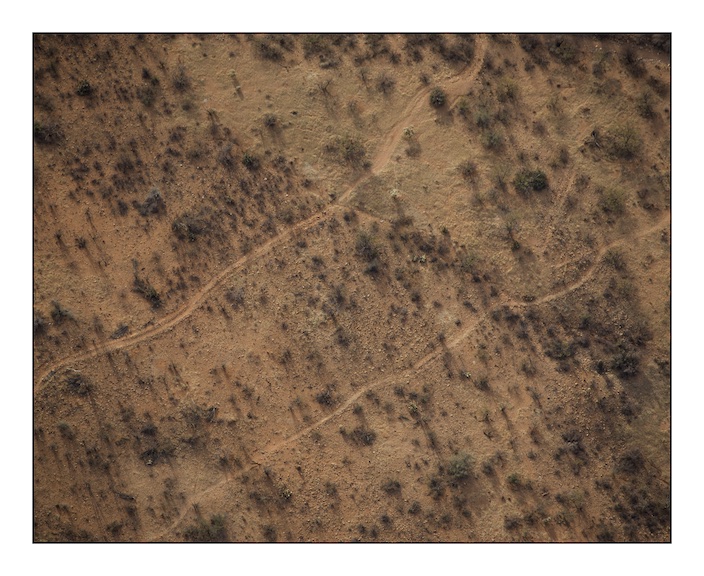
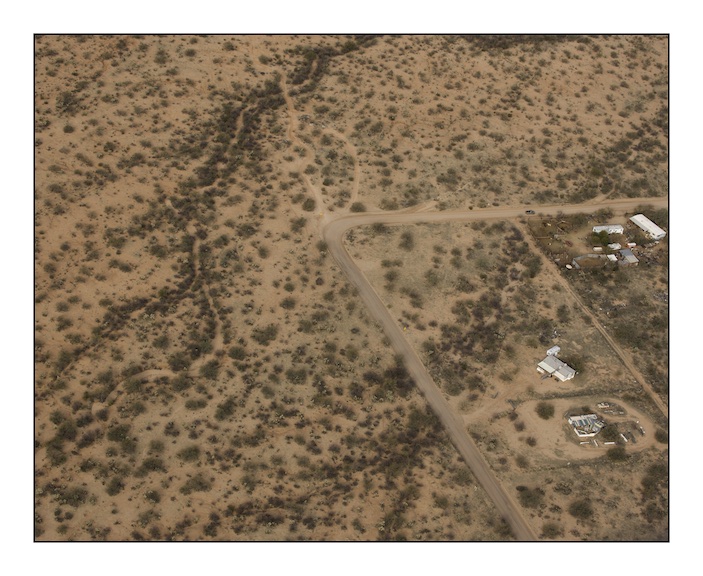
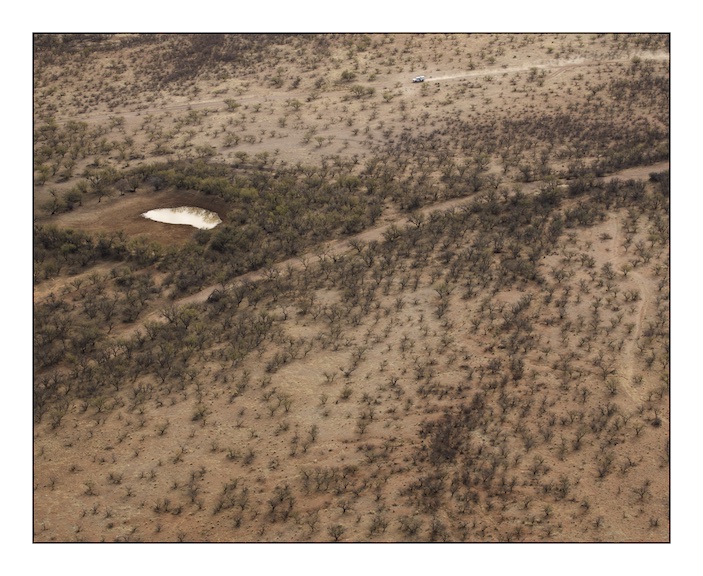
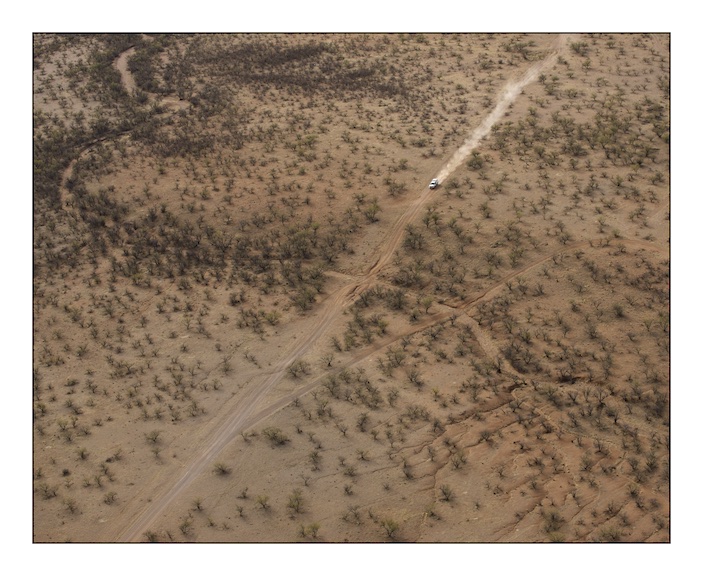
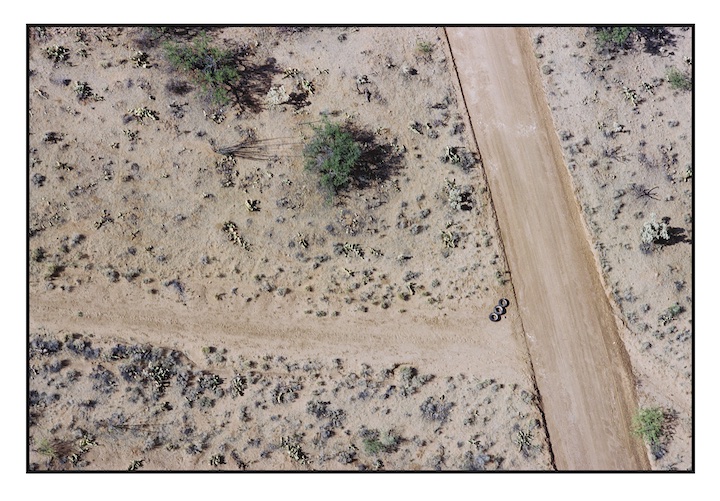
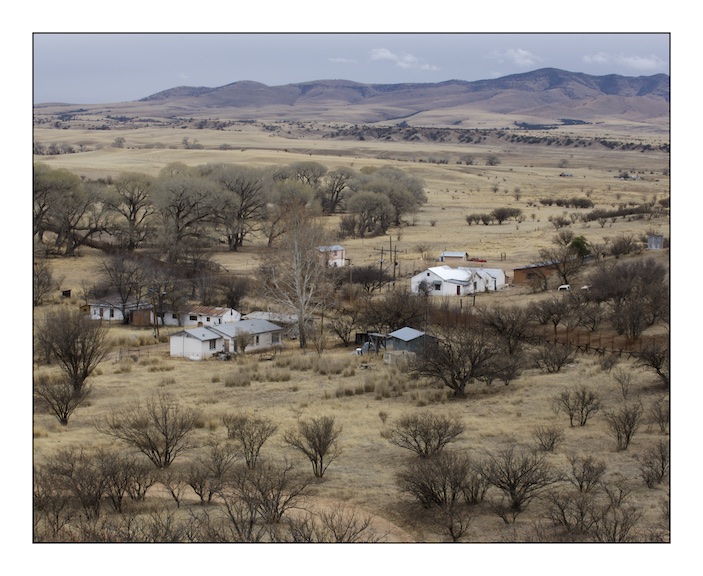
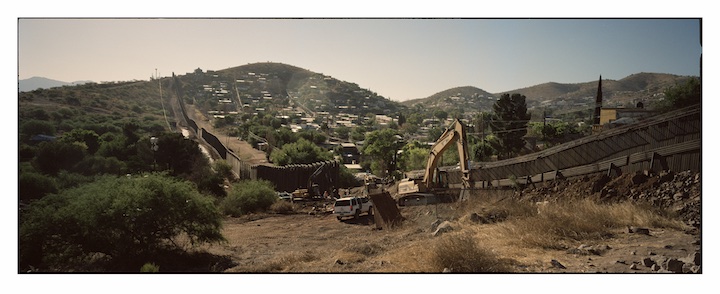
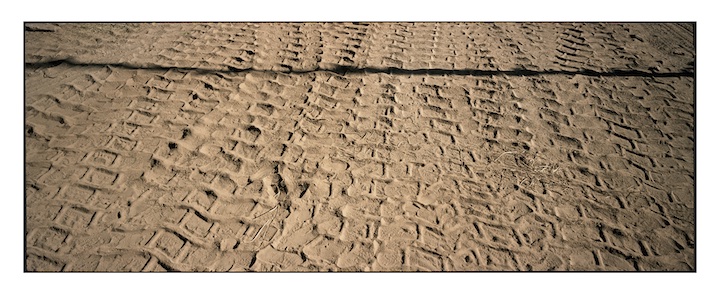
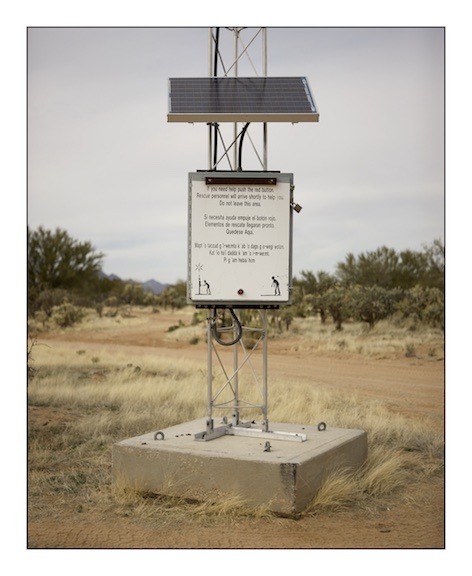
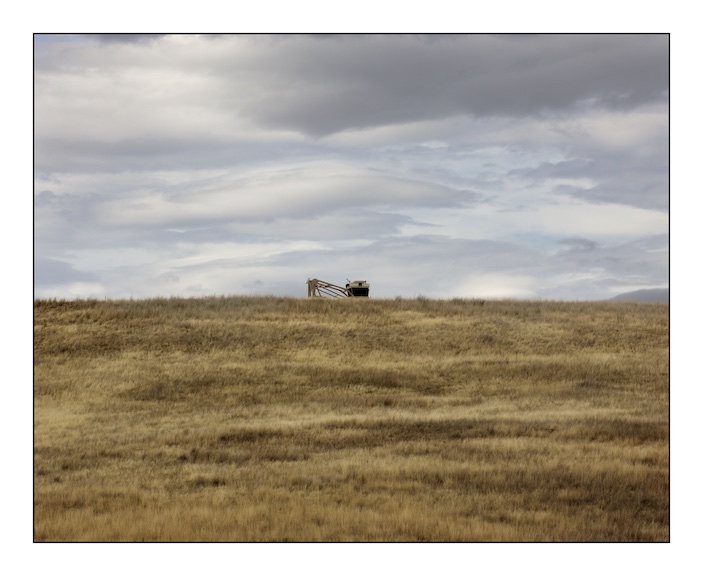
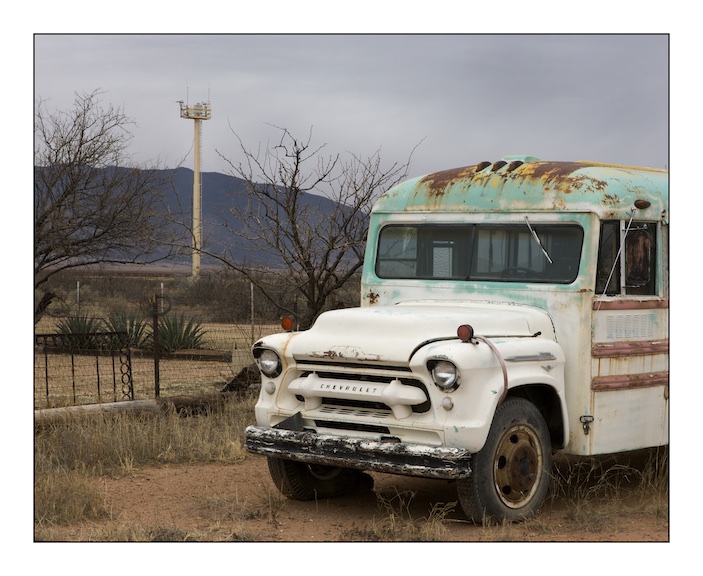
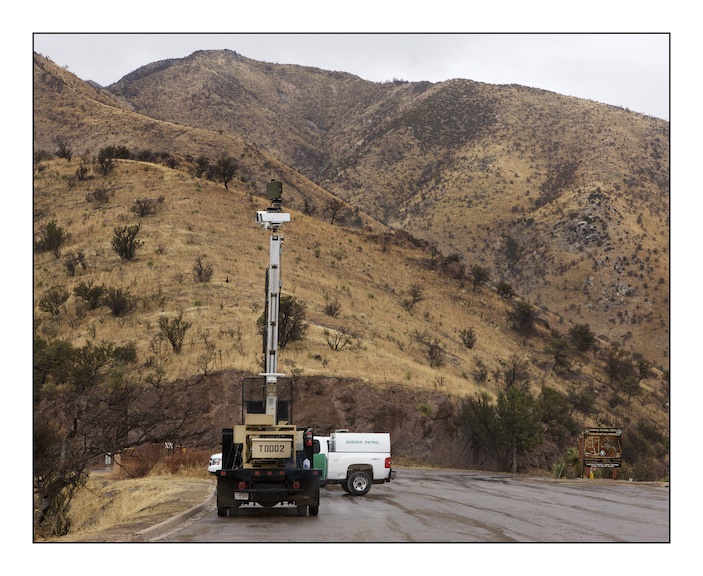
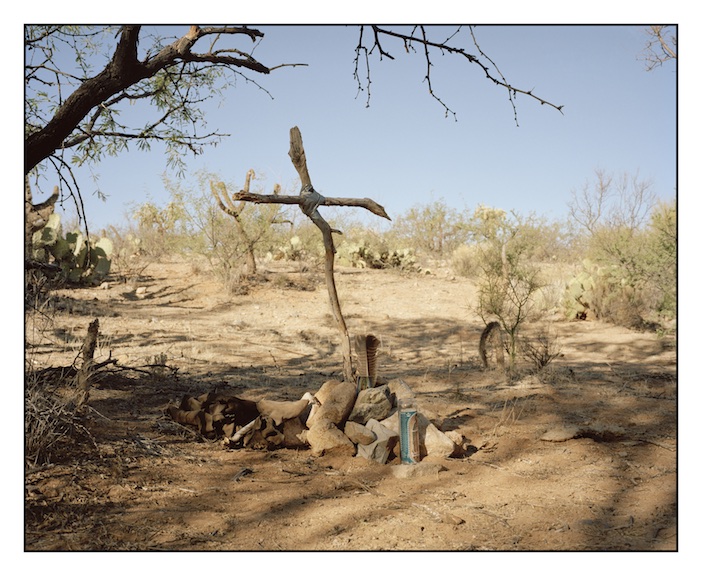
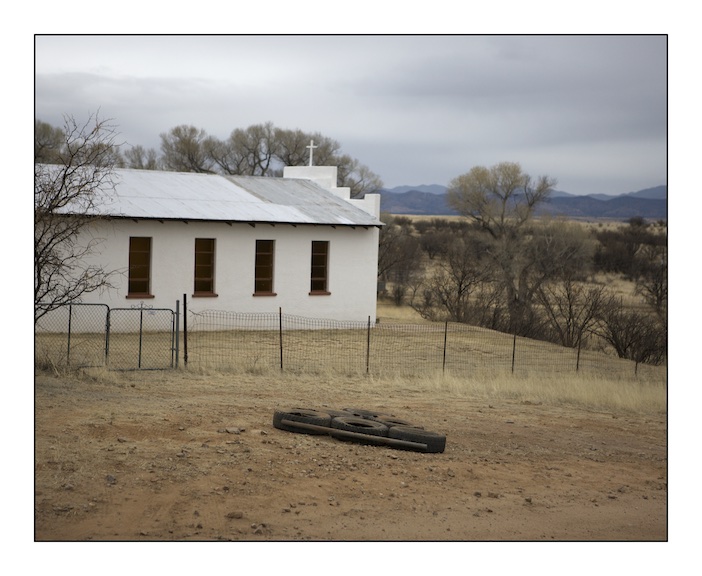
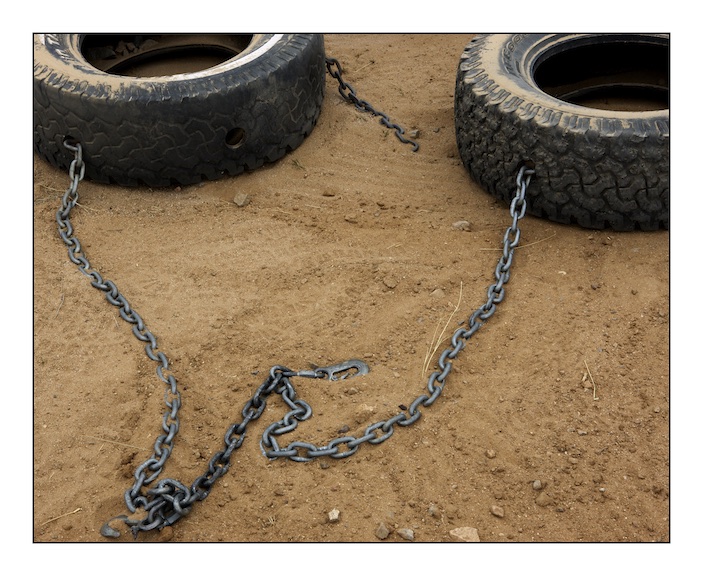
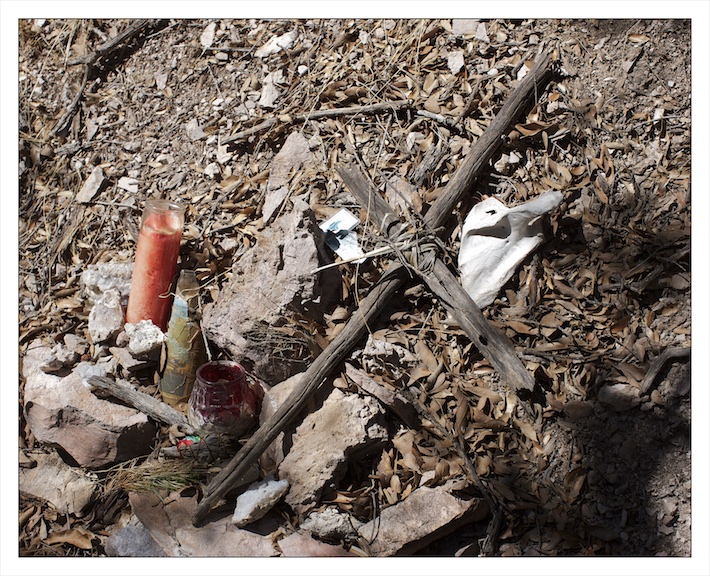
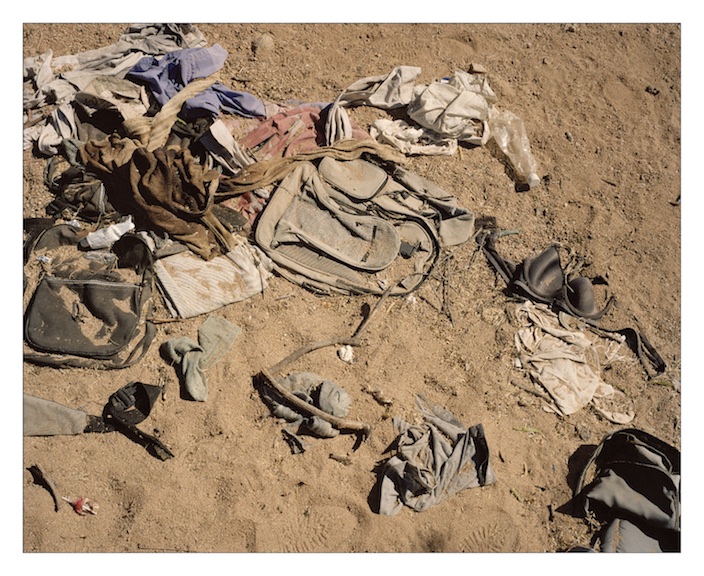
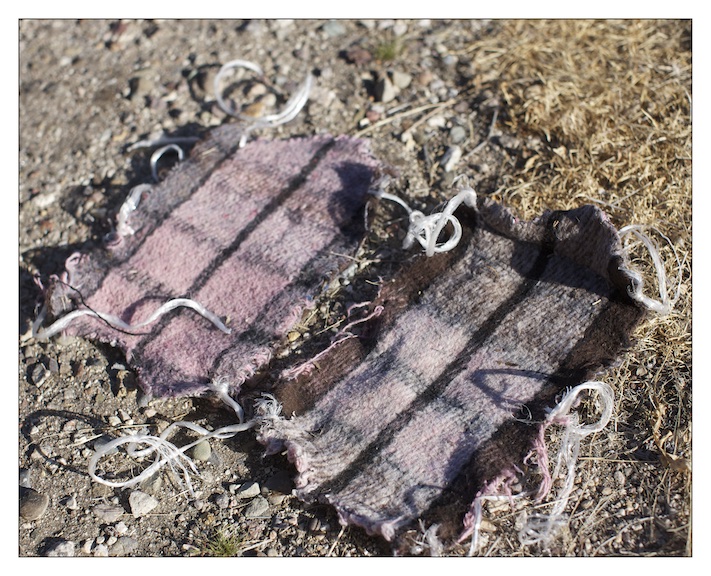

A US flag tethered to a family gatepost flutters in the afternoon breeze on the road between Arivaca and Amado, in the background is the Santa Clara mountain range.

The border fence between Mexico (on the left) and the United States (on the right) stops abruptly as the Baboquivari Mountains rise out of the desert near the hard scrabble town of Sassabe that straddles the border in southern Arizona. The fence costs over one million dollars per mile and in areas where the terrain is especially harsh and dangerous to cross the construction halts. The consequence of this is that migrants are forced into areas where human life is incredibly difficult to sustain and they die.

The border fence between Mexico (above) and the United States (below) stops abruptly as the Baboquivari Mountains rise out of the desert near the hard scrabble town of Sassabe that straddles the border in southern Arizona. The fence costs over one million dollars per mile and in areas where the terrain is especially harsh and dangerous to cross the construction halts. The consequence of this is that migrants are forced into areas where human life is incredibly difficult to sustain and they die.

The border fence between Mexico (above) and the United States (below) snakes it’s way through the desert scrub east of Nogales in the Pajarita Mountains in Southern Arizona.

The border fence between Mexico (above) and the United States (below) snakes it’s way through the once prosperous town of Nogales which straddles the border. Nogales was a town where Americans and Mexicans would visit frequently to trade goods and engage in commerce. Now businesses struggle and the value of real estate has dropped forcing many American families to live elsewhere.

The border fence between Mexico (above) and the United States (below) snakes it’s way through the once prosperous town of Nogales which straddles the border. Nogales was a town where Americans and Mexicans would visit frequently to trade goods and engage in commerce. Now businesses struggle and the value of real estate has dropped forcing many American families to live elsewhere.

Two United States Border Patrol vehicles parked next to their horses on a trail in Baboquivari Mountains in the Sonoran desert. The Border patrol use horses to patrol remote areas where their vehicles cannot pass.

Two United States Border Patrol vehicles parked on a trail in the Atascosa Mountains in the Coronado National Forest, Southern Arizona.

An overturned migrant vehicle in a dried river bed in the Altar Valley near Sasabe in Southern Arizona. Coyotes - the name given to human and drug traffickers - pick migrants up in pre-arranged locations in the desert and then drive them further into Arizona and the United States. Sometimes the vehicles are seen by the United States Border Patrol who chase them through the desert. The coyotes frequently crash their poorly equipped vehicles in the dark.

Traces of migration like these can be seen all over the desert. The track to the north is made by vehicles, probably United States Border Patrol and local farmers, the smaller track to the south and those that branch off from it will be used by cattle and migrants.

The bend in the road at the centre of this photograph is at Diamond Bells Ranch near Robles Junction. Diamond Bells was built as a restful and upscale desert retreat before the recent property market crash. In 2010, unbeknownst to the owner of the house volunteers from the American charity ‘The Samaritans” found the body of a Mexican migrant who had died very slowly of dehydration and exhaustion.

A solitary United States Border Patrol vehicle on patrol in the Coyote Mountains Wilderness, Southern Arizona.

A solitary United States Border Patrol vehicle on patrol in the Coyote Mountains Wilderness, Southern Arizona. Migrants will normally travel in dried river beds like the one seen running from top left to bottom right of this photograph. River beds have shade and offer some cover.

Three car tyres used by the United States Border Patrol to ‘cut’ the desert trail. ‘Cutting the trail’ entails dragging car tyres behind a vehicle to sweep the desert trail. This is usually done in the evening so that any migrant footprints made overnight will be visible in the morning and allow Border Patrol trackers to follow them through the desert.

The hamlet of Lochiel in the Coronado National Forest east of Nogales in Southern Arizona. The Border fence that divides Mexico from the United States cuts straight through the middle of this small settlement. Lochiel is now all but deserted, the only inhabitants I saw were on the Mexican side and they used the border fence as one wall of a chicken coop. Lochiel is close to the location where the Spanish conquistador Francisco Vasquez de Coronado led the first European migration into what is now the North American Southwest.

A solar powered beacon located in the desert for migrants who are unable to continue their journey. When the beacon is activated it sends a signal to the emergency services.

A hydraulically powered United States Border Patrol observation post hidden behind a hill very close to the border near the Santa Cruz River in the Coronado National Forest, Southern Arizona close to the location where the Spanish conquistador Francisco Vasquez de Coronado led the first European migration into what is now the North American Southwest.

A remotely operated observation post near the town of Douglas, Southern Arizona close to the location where the Spanish conquistador Francisco Vasquez de Coronado led the first European migration into what is now the North American Southwest. The border has become one of the most militarized and observed borders in the world. Hi tech industries that are developing drone and other surveillance technologies have a significant presence in the region. Border security is self perpetuating multi-million dollar industry.

A portable vehicle mounted observation post at Canelo Pass in the Coronado National Forest at the location where the Spanish conquistador Francisco Vasquez de Coronado led the first European migration into what is now the North American Southwest. The border has become one of the most militarized and observed borders in the world. Hi tech industries that are developing drone and other surveillance technologies have a significant presence in the region. Border security is self perpetuating multi-million dollar industry.

A cross made by a volunteer from the Tucson based charity ‘The Samaritans’ marks the grave of a Latin American migrant who died on the trail in the Tumacacori Mountains just west of Highway 19 and five miles from the border. There are many graves and shrines like this in the south western deserts. They are tended by American volunteers and migrants alike. Migrants will often forgo carrying precious life saving food and water so that they can carry candles and amulets to place on unmarked graves and shrines like this.

Six truck tyres used by the United States Border Patrol to ‘cut’ the desert trail. ‘Cutting the trail’ entails dragging car tyres behind a vehicle to sweep the desert trail. This is usually done in the evening so that any migrant footprints made overnight will be visible in the morning and allow Border Patrol trackers to follow them through the desert.

Truck tyres used by the United States Border Patrol to ‘cut’ the desert trail. ‘Cutting the trail’ entails dragging car tyres behind a vehicle to sweep the desert trail. This is usually done in the evening so that any migrant footprints made overnight will be visible in the morning and allow Border Patrol trackers to follow them through the desert.

A cross made by a volunteer from the Tucson based charity ‘The Samaritans’ marks the grave of a Latin American migrant who died on the trail in the Tumacacori Mountains just west of Highway 19 and five miles from the border. There are many graves and shrines like this in the south western deserts. They are tended by American volunteers and migrants alike. Migrants will often forgo carrying precious life saving food and water so that they can carry candles and amulets to place on unmarked graves and shrines like this.

The trails are littered with clothes that the migrants discard, either because they can no longer carry them or because they have reached the end of the trail and are waiting to be collected in a vehicle by the ‘coyotes’ who will drive them deeper into the United States. Women’s underwear is sometimes found trail. Women are often raped and their underwear hung on trees as trophies. Some women in shelters have told volunteer workers that they take contraceptive pills on the journey to prevent rape leading to pregnancy.